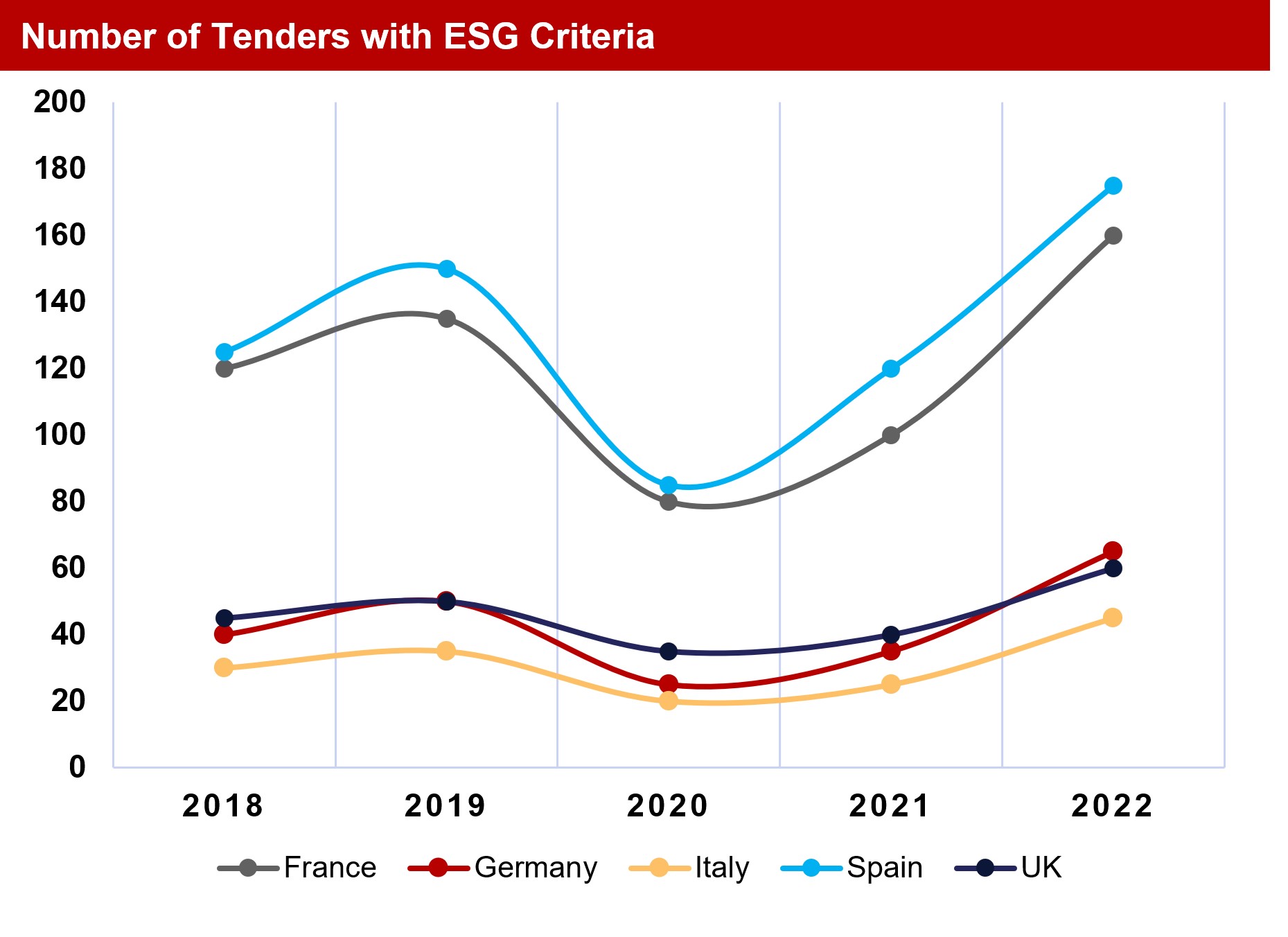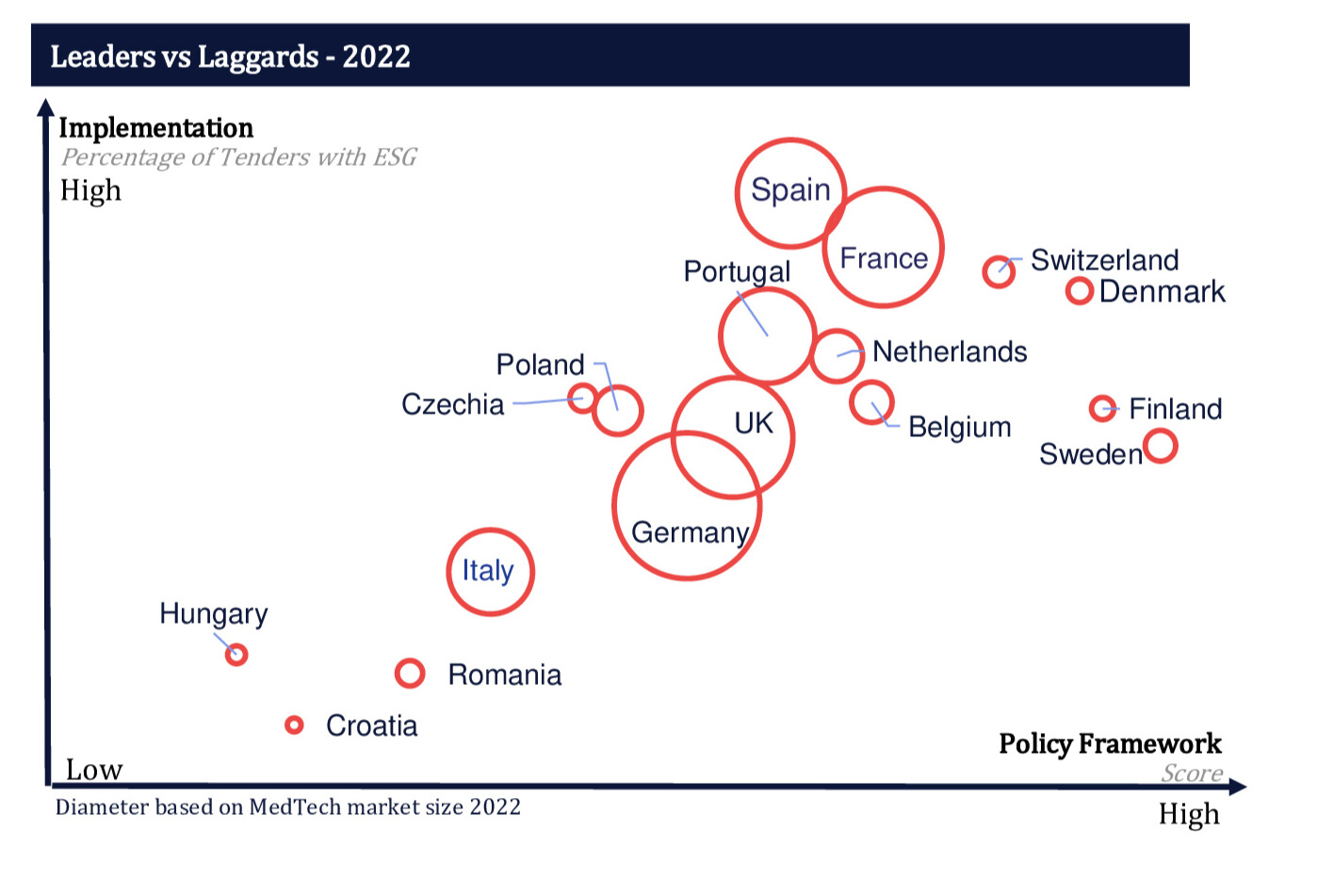The Rise of ESG Criteria in European MedTech Tenders
The healthcare industry is an essential part of societal well-being, but it also affects the environment. If global healthcare was seen as a country, it would be the fifth most greenhouse gas emitting country. In turn, climate change is expected to significantly impact how we organize healthcare as well, with an increase in mosquito-borne infections, pollen allergies, skin cancer, and heath-induced illnesses. Furthermore, the healthcare supply chain is thought to become more affected by extreme weather events. Because of this, many countries have implemented measures to move towards decarbonized or even net-zero healthcare over the last few years.
This policy movement is also visible in procurement for the European market. ESG (environment, social, and governance) criteria are used in procurement contracts to create environmental sustainability opportunities. MedTech Europe has commissioned Vamstar to conduct a high-level data analysis of the tender activity in various regions to gain insights into ESG adoption trends on the MedTech commercial landscape from 2018 onwards.
Methodology
Identifying the ESG trends in Europe is challenging, as it requires aggregation and sampling analysis of large amounts of data. Therefore, the Vamstar team of experienced AI and machine learning engineers developed state-of-the-art tools that aggregate tender data from more than a thousand sources and conduct targeted sampling in the relevant countries. Making sense of all these terabytes of aggregated data is an important step that can be compared to finding a needle in a haystack.
Data scientists and engineers work together to identify patterns and correlations by analyzing metadata and the precise language that is used in all these various tenders. Using AI can be extremely powerful in this difficult task, as shown by language-based AI models such as Google’s Bard and OpenAI’s Chat-GTP.
Next, the team used our proprietary AI to map when language regarding ESG criteria was included in tender data. Machine learning tools were used to develop a structured data model to enable more than 3,500 relevant tenders to be analyzed by product category. Secondary research on policy frameworks was added to the data analysis to create a complete view of ESG implementation. Lastly, emphasis was placed on human intelligence and health experts who critically assessed what other information was missing from the picture and how different factors in the tendering process influenced each other.
Policies that Influence ESG Implementation
Over the last five years, Vamstar has seen an increase in the amount of MedTech tenders that incorporate ESG criteria. We believe there is a strong momentum in ESG criteria adoption in the European MedTech sector, in addition to the more traditional transactional criteria, such as price. This growth is only to continue since many EU and local regulations require public health institutions and companies to adhere to these ESG criteria. For example, the Green Public Procurement directive encourages EU member countries to leverage their economic purchasing power to minimize the environmental impact. Additionally, the EU Medical Device Regulation details the reprocessing, recycling, and sustainability of medical devices. The Waste Electric and Electronic Equipment Directive and the Packaging and Packing Waste Directive both aim to increase sustainability by limiting, reusing, and recycling waste. An example of a national policy to move towards sustainability is Greener NHS, which requires products and services that are directly under NHS control to be net zero by 2040. Most ESG regulations are not product-specific but extend across various product segments, such as consumables, imaging, devices, and single-use items. Although several international and national policies promote the incorporation of ESG criteria, many MedTech products are subject to certain exemptions based on patient safety and hygiene requirements.
Insights
The analysis showed that there is strong momentum in ESG adoption in MedTech tenders in the five most populous European countries, with a compound annual growth rate (CAGR) of 7.5%. During the COVID-19 pandemic in 2020, the number of tenders with ESG criteria dropped to only 320, a 25% reduction from previous years. Since 2022, the number of tenders driven by ESG criteria is back on pre-pandemic levels and increasing from there. The average weight given to ESG criteria currently stands at approximately 7% across European countries.

How ESG criteria are evaluated and weighted in tenders varies among countries, buyers, and product categories. Norway has raised the ESG criteria weightage to 30% in some product categories. Data from German tenders also shows that although not all tenders include ESG criteria, the tenders that do contain those generally give high weightage to the ESG criteria. It was also observed that some buyers allocate only minimal weight to ESG. Whether this is the case to adhere to local regulations whilst still selecting existing suppliers and lower prices remains to be determined. However, it is a relevant observation in terms of the implementation of top-down required tender criteria.
Environmental Criteria Receive the Most Focus
Vamstar’s technology can identify language related to ESG themes to highlight which part of tenders focus on ESG criteria accurately. Examples of the language used to identify terms include the need for ‘eco-labels on products,’ the ‘percentage of recyclable equipment required,’ ‘carbon emission calculations,’ ‘adherence to various declarations regarding human and workers’ rights,’ societal challenges such as ‘inequities and equal opportunities,’ and ‘workers’ protections.’
Interestingly, environmental criteria far outweigh the social and governance criteria in terms of usage in European tenders, as 75 percent of tenders that stipulate ESG criteria include environmental requirements. The most frequently seen criterion within the environmental theme is the recyclability of products and packaging, while net-zero emissions or life cycle environmental impact assessments are least often required. Social requirements are made in about a third of the ESG-inclusive tenders. Contrarily, governance criteria are only mentioned in a fraction of the ESG-inclusive tenders. ESG criteria can be implemented in tenders based on mandatory criteria (qualification-driven), such as acts or regulations that must be adhered to, or value-adding criteria (weight-driven), such as guidelines, initiatives, or promises. These regulations and considerations are different between countries and regions.
Currently, the Nordics (Norway, Sweden, Finland, and Denmark) are leading the European implementation of healthcare tenders with ESG criteria, whilst some countries with bigger-sized MedTech industries, such as Italy and Germany, are still forming their national policy frameworks. Nonetheless, since most European countries are committed to quickly implementing these ESG criteria over the next few years, today’s laggards could become tomorrow’s leaders. Furthermore, some buyers are more aggressively selecting for ESG criteria than their country’s average, which shows that the MedTech tender process has both a local and international aspect.

Expanding Value-Based Procurement
Vamstar found that price remains a crucial element in awarding tender contracts, among other factors. Incorporating ESG criteria brings extra complexity to the already quite complex procurement process for healthcare products and services. Multiple ESG factors, as opposed to just a few price-related factors, are increasing the total number of elements that become relevant in the procurement process. This brings more variability, complexity, and questions to both buyers and sellers in the healthcare sector. How can you compare different providers efficiently and fairly on a wide set of factors? How can you quickly identify if your product could compete for a valuable, but complex tender?
Value-based procurement is an approach that uses ESG and price-related criteria to understand better which product or service would work best for a specific buyer – and society in general – ideally in the long term.
Finding the Optimal Balance in Value-Based Procurement
Market regulators, buyers, and suppliers must find a way to balance, on one side, the benefits and opportunities that ESG criteria provide, and on the other side, the difficulties and challenges that they create.
Benefits and opportunities other than the intended environmental and societal outcomes could be increased innovation in sustainable materials, recycling technologies, and creative disruptions in the supply chain. Reusing and recycling materials could also save costs and create new revenue streams simultaneously.
Challenges to the marketplace are a limited number of suppliers that can currently adhere to desired ESG criteria before innovations and changes are implemented among most suppliers. Meeting higher standards can come at a significant cost to suppliers, especially small suppliers operating in a niche market.
It can be complex to verify and monitor whether the supplier meets certain criteria and which regulatory body is qualified to do so. Furthermore, it needs to be clarified how different, contradictory ESG criteria should be implemented during times of emergencies, pandemics, or supply chain shortages.
Using AI to navigate ESG implementation in tendering
Artificial intelligence is increasingly being used to gather market intelligence and tendering information to create forecasts about value-based demand, pricing, trends, and competition in the sector to facilitate commercial decision-making.
AI is also utilized to read policy documentation and papers used among industry experts to create forecasts for the industry, including impacts on overall margins and market intelligence reports.
Additionally, Vamstar is in the process of using data analysis on research papers as the basis for clinical evidence to provide another unique dimension to value-based procurement.
At Vamstar, we strive to bring more efficiency and smooth sailing in procurement by using new tools and creative innovations. To gain further insight into Vamstar’s operations and how we can assist you in overcoming procurement obstacles, whether you are a buyer or supplier, you can schedule a call with our team of professionals.
MedTech | Sustainability | Europe | Buyers | Suppliers | Legislation | Due Diligence | Benchmarking | Consulting | Net Zero | Good Governance | Societal Impact

